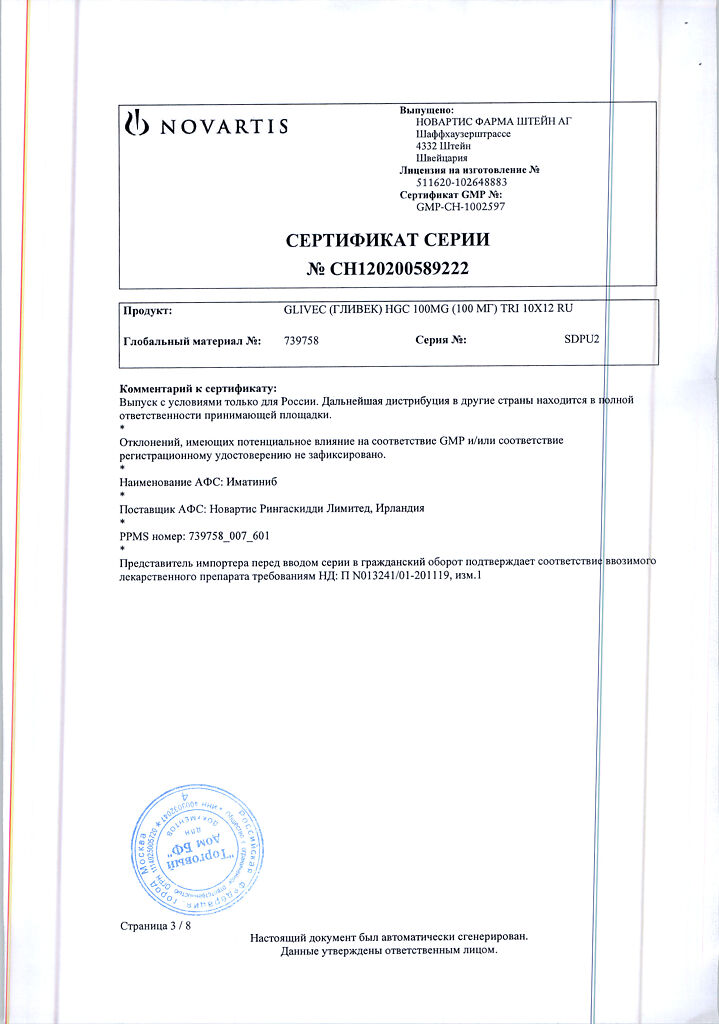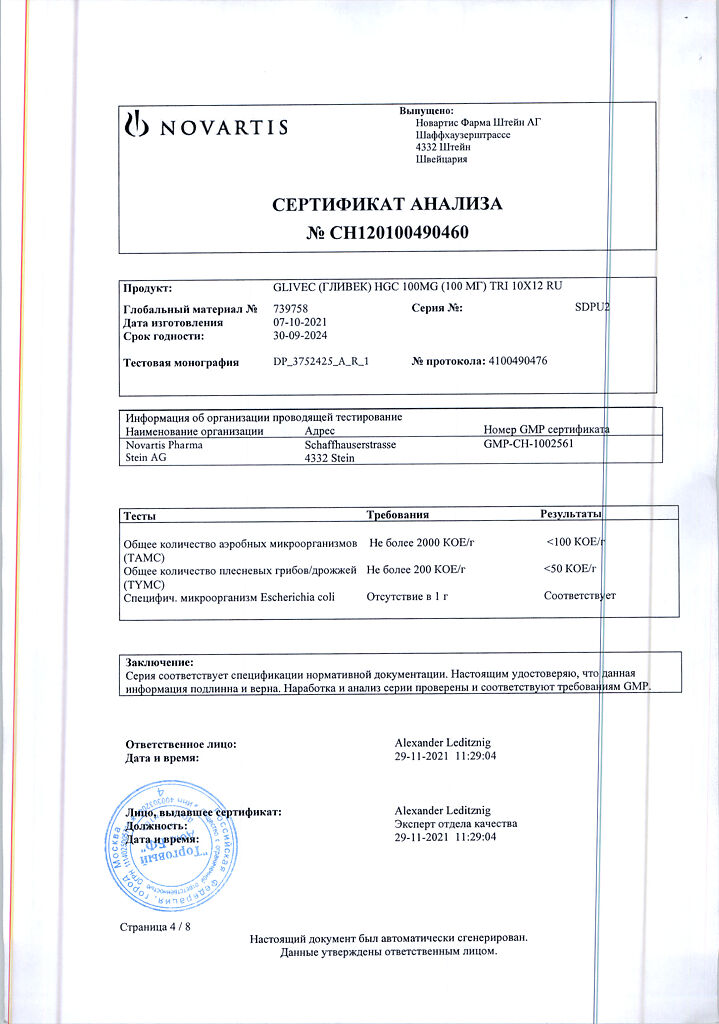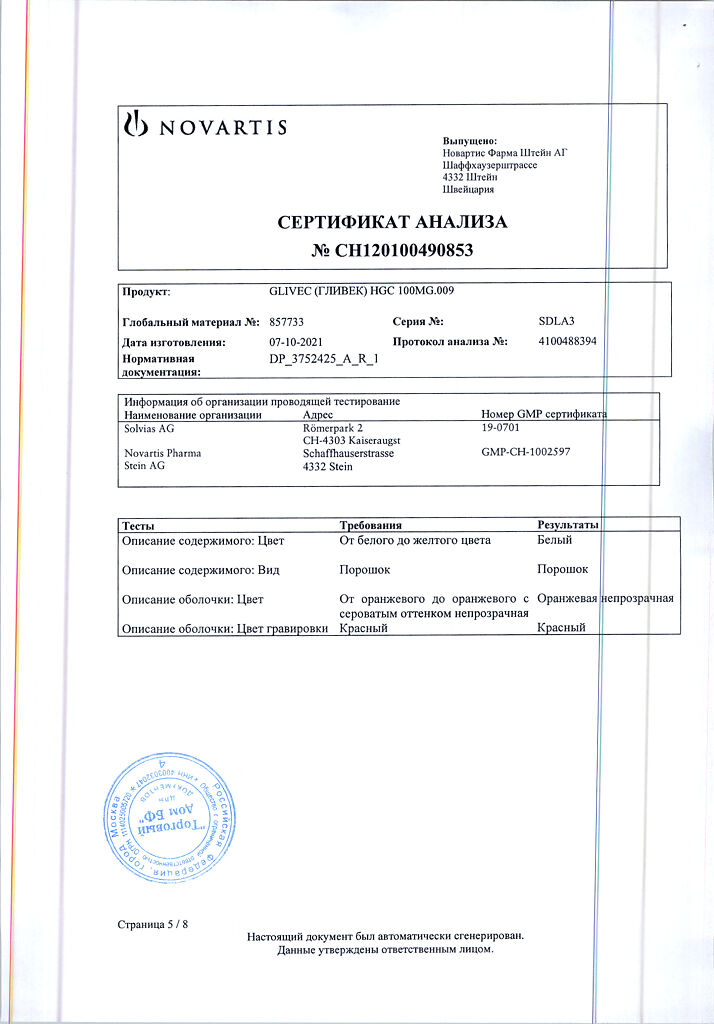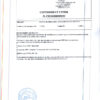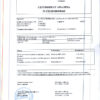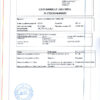No products in the cart.
Description
Pharmacodynamics
Antitumor drug, proteinutyrosine kinase inhibitor.
. Imatinib has a selective inhibitory effect on the enzyme Bcr-Abl-tyrosine kinase, which is formed at the fusion of the Bcr gene site (breakpoint cluster region) and Abl (Abelson) protooncogene, at the cellular level, selectively inhibits proliferation and causes apoptosis of cell lines, expressing Bcr-Abl tyrosine kinase, including immature leukemia cells produced by patients with Philadelphia chromosome-positive chronic myeloleukemia and acute lymphoblastic leukemia.
Imatinib selectively inhibits Bcr-Abl-positive colonies derived from blood cells of patients with chronic myeloleukemia.
Imatinib inhibits proliferation and induces apoptosis of GI stromal tumor cells expressing tyrosine kinase with a c-Kit receptor mutation.
The activation of receptors to platelet-derived growth factor or Abl-fragment tyrosine kinase may be the cause of both myelodysplastic/myeloproliferative diseases and hypereosinophilic syndrome and chronic eosinophilic leukemia and bulging dermatofibrosarcoma.
The activation of c-Kit receptor tyrosine kinase and receptors to platelet-derived growth factors may underlie the pathogenesis of systemic mastocytosis. Imatinib inhibits cell signaling and cell proliferation resulting from the dysregulation of platelet and stem cell growth factor activity, c-Kit receptor and Abl-fragment tyrosine kinase.
The use of imatinib in patients with inoperable and/or metastatic malignant gastrointestinal stromal tumors showed a significant increase in overall patient survival (48.8 months) and symptom-free survival (21 months).
Adjuvant therapy with gastrointestinal stromal tumors reduced the risk of recurrence by 89% and increased survival without evidence of disease (38 months imatinib versus 20 months placebo).
Adjuvant therapy with gastrointestinal stromal tumors for 3 years results in significantly increased overall survival and progression-free survival compared to therapy for 1 year.
Pharmacokinetics
The pharmacokinetic parameters of Glivec were evaluated over a dose range of 25 mg to 1,000 mg. Pharmacokinetic profiles were analyzed on day 1 of administration and when equilibrium plasma concentrations of imatinib were reached on day 7 or day 28.
Eabsorption
After oral administration, the bioavailability of the drug averages 98%. The coefficient of variation for AUC is 40-60%. In the dose range from 25 to 1000 mg a direct linear dependence of AUC value on the value of the dose is noted.
When the drug is taken with a high-fat meal, compared to an empty stomach, a slight decrease in the degree of absorption is noted (decrease in Cmax of imatinib in plasma by 11%, AUC by 7.4%) and delayed absorption rate (increase in Tmax of imatinib in plasma by 1.5 h).
Distribution
The binding of imatinib to plasma proteins is about 95% (mainly to albumin and acidic α-glycoproteins, to a small extent to lipoproteins).
Metabolism
Imatinib is metabolized mainly in the liver to form the main metabolite (N-demethylated piperazine derivative) circulating in the systemic blood stream. In vitro metabolite of imatinib has pharmacological activity similar to that of the parent substance. The AUC of the metabolite is 16% of the AUC of imatinib.
The metabolite’s binding to plasma proteins is similar to that of imatinib.
The drug is excreted from the body within 7 days after a single dose, mainly as metabolites (68% – in the feces and 13% – in the urine). About 25% of the dose is excreted unchanged (20% – with feces and 5% – in the urine). T1/2 of imatinib is about 18 h.
The pharmacokinetic parameters do not change with repeated doses of the drug 1 time/day, and the Css of imatinib is 1.5-2.5 times higher than the initial dose.
Pharmacokinetics in Special Clinical Cases
In patients over 65 years of age, Vd increases slightly (by 12%).
In patients with a body weight of 50 kg, the average clearance of imatinib is 8.5 l/h, and in patients with a body weight of 100 kg it is 11.8 l/h. However, these differences are not significant and do not require adjusting the drug dose according to the patient’s body weight.
The pharmacokinetics of imatinib are independent of gender.
Changes in clearance and Vd of imatinib when used concomitantly with other drugs are not significant and do not require dose adjustments.
In children and adolescents under 18 years of age, as in adults, imatinib is rapidly absorbed after oral administration. The AUC in the dose range of 260 and 340 mg/m2 is similar to that in adults in the dose range of 400 mg and 600 mg, respectively.
When comparing AUC(0-24) values in children and adolescents on days 1 and 8 after repeated doses of the drug at 340 mg/m2 once daily, there was a 1.7-fold increase in this value, indicating cumulation of imatinib.
In patients with varying degrees of hepatic impairment the average AUC values are not increased.
In patients with mild to moderate renal impairment (CK > 30 ml/min), an increase of 1.5-2.0-fold in plasma exposure of imatinib is noted, corresponding to an increase in the concentration of acidic α-glycoproteins (major plasma proteins that bind to imatinib).
As the drug is slightly excreted by the kidneys, the clearance of free imatinib was similar in healthy volunteers and patients with impaired renal function. No correlation was found between drug exposure and severity of renal impairment.
Indications
Indications
Newly diagnosed Philadelphia chromosome positive (Ph+) chronic myeloid leukemia (CML) in children and adults;
Ph+ CML in the chronic phase with failure of previous interferon alpha therapy or in the acceleration phase, or blast crisis in children and adults;
newly diagnosed Philadelphia chromosome positive (Ph+) acute lymphoblastic leukemia (ALL) in adult patients in combination with chemotherapy;
relapsed or refractory Ph+ ALL in adult patients as monotherapy;
myelodysplastic/myeloproliferative diseases associated with gene rearrangements of the platelet growth factor receptor in adult patients;
systemic mastocytosis in adult patients with no D816V c-Kit mutation or with unknown c-Kit mutation status;
hypereosinophilic syndrome and/or chronic eosinophilic leukemia in adults with positive or negative abnormal FIP1L1-PDGRF alpha-tyrosine kinase;
unresectable and/or metastatic malignant gastrointestinal stromal tumors positive for c-Kit (CD 117) in adult patients;
adjuvant therapy of gastrointestinal stromal tumors positive for c-Kit (CD 117) in adult patients;
inoperable, recurrent and/or metastatic dermatofibrosarcoma protuberans in adult patients.
Pharmacological effect
Pharmacological effect
Pharmacodynamics
Antitumor drug, protein tyrosine kinase inhibitor.
Imatinib has a selective inhibitory effect on the enzyme Bcr-Abl tyrosine kinase, formed by the fusion of the Bcr gene (breakpoint cluster region) and the Abl proto-oncogene (Abelson), at the cellular level, selectively suppresses proliferation and causes apoptosis of cell lines expressing Bcr-Abl tyrosine kinase, including immature leukemia cells formed in patients with positive Philadelphia chromosome chronic myeloid leukemia and acute lymphoblastic leukemia.
Imatinib selectively inhibits Bcr-Abl-positive colonies derived from blood cells of patients with chronic myeloid leukemia.
Imatinib inhibits proliferation and induces apoptosis of gastrointestinal stromal tumor cells expressing tyrosine kinase with a c-Kit receptor mutation.
Activation of receptors for platelet growth factors or the Abl fragment of tyrosine kinase can cause the development of both myelodysplastic/myeloproliferative diseases and hypereosinophilic syndrome and chronic eosinophilic leukemia and dermatofibrosarcoma protuberans.
Activation of c-Kit receptor tyrosine kinase and platelet growth factor receptors may underlie the pathogenesis of systemic mastocytosis. Imatinib inhibits cell signaling and cell proliferation resulting from dysregulation of platelet and stem cell growth factors, c-Kit receptor and Abl tyrosine kinase.
When using imatinib in patients with unresectable and/or metastatic malignant gastrointestinal stromal tumors, there was a significant increase in overall patient survival (48.8 months) and disease-free survival (21 months).
Adjuvant drug therapy for gastrointestinal stromal tumors reduces the risk of relapse by 89% and increases disease-free survival (38 months imatinib versus 20 months placebo).
Adjuvant drug therapy for gastrointestinal stromal tumors for 3 years results in a significant increase in overall survival and progression-free survival compared with therapy for 1 year.
Pharmacokinetics
The pharmacokinetic parameters of Gleevec were assessed over a dose range from 25 mg to 1000 mg. Pharmacokinetic profiles were analyzed on day 1 of dosing and when steady-state imatinib plasma concentrations were reached on days 7 or 28.
Suction
After oral administration, the bioavailability of the drug averages 98%. The coefficient of variation for AUC is 40-60%. In the dose range from 25 to 1000 mg, a direct linear dependence of the AUC value on the dose was observed.
When taking the drug with a high-fat meal, compared to taking it on an empty stomach, there is a slight decrease in the degree of absorption (decrease in Cmax of imatinib in blood plasma by 11%, AUC by 7.4%) and a slower rate of absorption (increase in Tmax of imatinib in blood plasma by 1.5 hours).
Distribution
The binding of imatinib to plasma proteins is about 95% (mainly to albumin and acid α-glycoproteins, to a small extent to lipoproteins).
Metabolism
Imatinib is metabolized primarily in the liver to form a major metabolite (N-demethylated piperazine derivative) that circulates in the systemic circulation. In vitro, the imatinib metabolite has pharmacological activity similar to that of the parent substance. The AUC value of the metabolite is 16% of the AUC of imatinib.
The binding of the metabolite to plasma proteins is similar to that of imatinib.
Removal
After taking one dose, the drug is excreted from the body within 7 days, mainly in the form of metabolites (68% in feces and 13% in urine). About 25% of the dose is excreted unchanged (20% in feces and 5% in urine). T1/2 of imatinib is about 18 hours.
With repeated dosing of the drug once a day, the pharmacokinetic parameters do not change, and the Css of imatinib exceeds the initial value by 1.5-2.5 times.
Pharmacokinetics in special clinical situations
In patients over 65 years of age, Vd increases slightly (by 12%).
For patients weighing 50 kg, the average clearance of imatinib is 8.5 l/h, and for patients weighing 100 kg – 11.8 l/h. However, these differences are not significant and do not require dose adjustment depending on the patient’s body weight.
The pharmacokinetics of imatinib are independent of gender.
Changes in clearance and Vd of imatinib when used simultaneously with other drugs are insignificant and do not require dose changes.
In children and adolescents under 18 years of age, as in adults, imatinib is rapidly absorbed after oral administration. AUC in the 260 and 340 mg/m2 dose ranges is similar to that in adults in the 400 mg and 600 mg dose ranges, respectively.
When comparing AUC(0-24) values in children and adolescents on the 1st and 8th days after repeated administration of the drug at a dose of 340 mg/m2 1 time/day, an increase in the value of this indicator by 1.7 times is noted, indicating the accumulation of imatinib.
In patients with varying degrees of liver dysfunction, mean AUC values do not increase.
When using imatinib in patients with mild or moderate renal impairment (creatinine clearance > 30 ml/min), there is an increase in plasma drug exposure by 1.5-2.0 times, corresponding to an increase in the concentration of acidic α-glycoproteins (the main plasma proteins that bind to imatinib).
Because the drug is negligibly excreted by the kidneys, clearance of free imatinib was similar in healthy volunteers and patients with impaired renal function. There was no correlation between drug exposure and the severity of renal disorders.
Special instructions
Special instructions
Treatment with Gleevec should only be carried out under the supervision of a physician experienced in working with anticancer drugs.
When handling the drug, avoid contact with the skin and eyes, as well as inhalation of the drug powder.
When using Gleevec, it is recommended to conduct regular clinical studies of peripheral blood and monitoring liver function (transaminases, bilirubin, alkaline phosphatase).
Patients with heart disease should be closely monitored.
Due to the fact that when using Gleevec in 1-2% of cases, severe fluid retention is observed, it is recommended to regularly monitor the body weight of patients.
In the event of a rapid, unexpected increase in body weight, the patient should be examined and, if necessary, temporarily discontinue Gleevec therapy and/or prescribe diuretics. The highest incidence of fluid retention is observed in elderly patients with cardiovascular diseases.
In some cases, severe fluid retention can be severe and fatal. When using the drug, the death of a patient with blast crisis and complex symptoms: pleural effusion, chronic heart and renal failure was observed.
When prescribing the drug to patients with liver disease, clinical tests of peripheral blood and liver enzymes should be performed regularly.
Since there are reports of the development of hypothyroidism during the use of Gleevec in patients who have undergone thyroidectomy and are receiving levothyroxine replacement therapy, it is necessary to regularly determine the concentration of TSH in this category of patients.
In patients with hypereosinophilia syndrome and heart disease, isolated cases of cardiogenic shock/left ventricular failure have been reported at the start of imatinib therapy.
These undesirable effects are relieved after the introduction of systemic corticosteroids, the adoption of measures aimed at maintaining blood circulation, and temporary withdrawal of the drug Glivec®.
In patients with MDS/MPD and high levels of eosinophils, an ECG study should be performed and the serum concentration of cardiac-specific troponin should be determined.
If abnormalities are detected, at the beginning of therapy the possibility of prophylactic use of systemic corticosteroids (1-2 mg/kg) for 1-2 weeks simultaneously with imatinib should be considered.
In patients with unresectable and/or metastatic malignant gastrointestinal stromal tumors in phase III clinical studies, bleeding of various locations was observed in 12.9% of cases; in phase II studies, gastrointestinal bleeding was observed in 8 patients (5.4%), bleeding from tumor foci – in 4 patients (2.7%).
Bleeding was observed both in the abdominal organs and in the liver, depending on the location of the tumor foci. It is necessary to monitor the gastrointestinal tract in patients with metastatic malignant gastrointestinal stromal tumors when initiating imatinib therapy.
During therapy with Gleevec and for at least 3 months after, patients should use reliable methods of contraception.
Marked increases in transaminases or bilirubin levels were observed in less than 3% of patients with CML and were usually controlled by dose reduction or temporary interruption of treatment (the average duration of such episodes was about 1 week).
Due to the risk of developing tumor lysis syndrome, before prescribing Glivec®, clinically significant dehydration and elevated uric acid levels in patients should be corrected, if necessary.
Use in pediatrics
Experience in treating children under 2 years of age with CML with Glivec® is limited, and experience with the drug for other indications is limited in patients under 18 years of age.
The long-term effects of long-term exposure to Gleevec on growth in children are unknown. But because There have been reports of cases of growth retardation; careful growth monitoring is recommended in children receiving Gleevec®.
Impact on the ability to drive vehicles and other mechanisms that require increased concentration
Some adverse reactions of the drug, such as dizziness and blurred vision, may adversely affect the ability to drive a car and perform potentially hazardous activities that require increased concentration and speed of psychomotor reactions.
In this regard, patients receiving Glivec® should exercise increased attention and caution when driving vehicles and performing potentially hazardous activities.
Active ingredient
Active ingredient
Imatinib
Composition
Composition
1 capsule contains:
Active ingredients:
Imatinib mesylate 119.5 mg, which corresponds to the content of imatinib 100 mg.
Excipients:
microcrystalline cellulose – 92 mg,
crospovidone – 15 mg,
colloidal silicon dioxide anhydrous – 2 mg,
magnesium stearate – 1.5 mg,
titanium dioxide – 600 mcg,
gelatin – 74.81 mg,
iron oxide yellow dye – 30 mcg,
red iron oxide dye – 560 mcg.
Ink composition:
iron oxide red dye (E172),
shellac,
soy lecithin.
Contraindications
Contraindications
Pregnancy;
lactation period (breastfeeding);
children under 2 years of age (efficacy and safety have not yet been established);
hypersensitivity to the components of the drug.
With caution: Gleevec should be prescribed to patients with severe liver failure, severe renal impairment, cardiovascular disease or in the presence of risk factors for heart failure, as well as during regular hemodialysis.
Side Effects
Side Effects
The safety profile of Glivec® has been well studied.
Most patients experience some kind of adverse events when using the drug. The most common adverse events (>10%) associated with taking the drug were: neutropenia, thrombocytopenia, anemia, headache, dyspepsia, edema, weight gain, nausea, vomiting, diarrhea, myalgia, muscle cramps, rash, weakness, abdominal pain.
These adverse events were generally mild or moderate. Only 2-5% of patients stopped therapy with Glivec® due to the development of adverse events.
Myelosuppression, gastrointestinal adverse events, edema and rash occur with the use of imatinib in both CML and malignant gastrointestinal stromal tumors.
Patients with CML are more likely to develop myelosuppression, and patients with malignant stromal tumors of the gastrointestinal tract are more likely to experience gastrointestinal and intratumoral bleeding.
Other gastrointestinal abnormalities, such as gastrointestinal obstruction, perforation, and ulceration, are more common with gastrointestinal stromal tumors.
Other serious adverse events with imatinib include hepatotoxicity, acute renal failure, hypophosphatemia, respiratory disorders, tumor lysis syndrome and growth retardation in children.
It is possible to adjust the dose of the drug depending on the severity of adverse events, up to and including discontinuation of the drug.
During clinical trials in patients with CML and unresectable and/or metastatic malignant stromal tumors of the gastrointestinal tract, the following adverse events were observed, listed below by organ and system with an indication of the frequency of their occurrence:
very often (≥1/10);
often (≥1/100, <1/10);
uncommon (≥1/1000, <1/100);
rare (≥1/10,000, <1/1000);
very rare (<1/10,000), incl. separate messages.
Infectious diseases: infrequently – herpes simplex, herpes zoster, nasopharyngitis, pneumonia1, sinusitis, inflammation of the subcutaneous tissue, upper respiratory tract infections, influenza, urinary tract infections, gastroenteritis, sepsis; rarely – mycoses.
Benign, malignant and unspecified neoplasms (including polyps and cysts): rarely – tumor lysis syndrome.
From the hematopoietic system: very often – neutropenia, thrombocytopenia, anemia; often – pancytopenia, febrile neutropenia; uncommon – thrombocythemia, lymphopenia, suppression of bone marrow hematopoiesis, eosinophilia, lymphadenopathy; rarely – hemolytic anemia.
Metabolism: often – anorexia; uncommon – hypokalemia, increased or decreased appetite, hypophosphatemia, dehydration, hyperuricemia, gout, hypercalcemia, hyperglycemia, hyponatremia; rarely – hyperkalemia, hypomagnesemia.
From the nervous system: very often – headache2; often – dizziness, taste disturbance, paresthesia, hypoesthesia, insomnia; uncommon – hemorrhagic stroke, fainting, peripheral neuropathy, drowsiness, migraine, memory impairment, sciatica, restless legs syndrome, tremor, depression, anxiety, decreased libido; rarely – increased intracranial pressure, convulsions, optic neuritis, confusion.
From the organ of vision: often – swelling of the eyelids, increased lacrimation, hemorrhage in the conjunctiva, conjunctivitis, dry eye syndrome, blurred vision; uncommon – eye irritation, eye pain, orbital edema, hemorrhage in the sclera of the eye, retinal hemorrhages, blepharitis, macular edema; rarely – cataracts, papilledema, glaucoma.
From the organ of hearing and labyrinthine disorders: infrequently – vertigo, tinnitus, hearing loss.
From the cardiovascular system: infrequently – palpitations, congestive heart failure3, pulmonary edema, tachycardia, hot flashes4, hemorrhages4; rarely – arrhythmias, atrial fibrillation, sudden cardiac arrest, myocardial infarction, angina pectoris, pericardial effusion, arterial hypertension, hematomas, cold extremities, arterial hypotension, Raynaud’s syndrome, decreased blood pressure.
From the respiratory system: often – nosebleeds, shortness of breath, cough; uncommon – pleural effusion5, pain in the pharynx or larynx, pharyngitis; rarely – pleural pain, pulmonary fibrosis, pulmonary hypertension, pulmonary hemorrhage.
From the digestive system: very often – nausea, vomiting, diarrhea, dyspepsia, abdominal pain6; often – bloating, flatulence, constipation, gastroesophageal reflux, dry mouth, gastritis, increased activity of liver transaminases; uncommon – stomatitis, ulceration of the oral mucosa, gastrointestinal bleeding7, belching, melena, esophagitis, ascites, gastric ulcer, vomiting blood, cheilitis, dysphagia, pancreatitis, hyperbilirubinemia, jaundice, hepatitis; rarely – colitis, paralytic/obstructive intestinal obstruction, inflammatory bowel disease, liver failure9, liver necrosis9.
Dermatological reactions: very often – periorbital edema, dermatitis, eczema, skin rash; often – swelling of the face, itching, erythema, dry skin, erythema, alopecia, night sweats, photosensitivity reactions; uncommon – pustular rash, bruises, increased sweating, urticaria, ecchymoses, increased susceptibility to hematoma formation, hypotrichosis, hyperpigmentation/hypopigmentation of the skin, exfoliative dermatitis, nail damage, folliculitis, petechiae, psoriasis, purpura, bullous rash; rarely – discoloration of nails, acute febrile neutrophilic dermatosis (Sweet’s syndrome), angioedema, erythema multiforme, leukoclastic vasculitis, Stevens-Johnson syndrome, acute generalized pustular exanthema.
From the musculoskeletal system: very often – muscle spasms and cramps, musculoskeletal pain (including myalgia, arthralgia, bone pain8); often – swelling of the joints; infrequently – stiffness of muscles and joints; rarely – muscle weakness, arthritis; frequency unknown – growth retardation in children.
From the urinary system: uncommon – kidney pain, hematuria, acute renal failure, frequent urination.
From the reproductive system: uncommon – gynecomastia, erectile dysfunction, menorrhagia, menstrual irregularities, sexual dysfunction, nipple pain, breast enlargement, scrotal swelling.
General reactions: very often – fluid retention, swelling, increased fatigue, weight gain; often – weakness, fever, anasarca, chills, trembling, weight loss; uncommon – chest pain, general malaise.
From laboratory parameters: infrequently – increased activity of alkaline phosphatase, CPK, LDH and creatinine content in the blood serum; rarely – increased amylase activity in blood plasma.
1 – Pneumonia was most often observed in patients with CML in the accelerated phase, blast crisis and with inoperable and/or metastatic malignant gastrointestinal stromal tumors of the gastrointestinal tract.
2 – Headache was most often observed in patients with inoperable and/or metastatic malignant tumors of the gastrointestinal tract.
3 – Adverse cardiac events, including congestive heart failure, were more often observed in patients with CML in the accelerated phase and during blast crisis compared with patients with CML in the chronic phase (follow-up duration – 1 year).
4 – Hot flashes were most often observed in patients with inoperable and/or metastatic malignant tumors of the gastrointestinal tract; Bleeding (hematomas, hemorrhages) was most often observed in patients with CML in the acceleration phase, blast crisis and with inoperable and/or metastatic malignant tumors of the gastrointestinal tract.
5 – Pleural effusion was more often observed in patients with CML in the acceleration phase and during blast crisis compared to CML in the chronic phase (observation duration – 1 year).
6/7 – Abdominal pain and gastrointestinal bleeding were most often observed in patients with inoperable and/or metastatic gastrointestinal malignancies.
8 – Musculoskeletal pain (including myalgia, arthralgia, bone pain) was more often observed in patients with CML compared with patients with unresectable and/or metastatic malignant tumors of the gastrointestinal tract.
9 – Isolated cases of liver failure and liver necrosis have been reported.
When using the drug Glivec® in clinical practice, as well as during additional clinical studies, the following adverse reactions were noted, listed by organs and systems, indicating the frequency of their occurrence:
very often (≥1/10);
often (≥1/100, <1/10);
uncommon (≥1/1000, <1/100);
rare (≥1/10,000, <1/1000);
very rare (<1/10,000), incl. separate messages.
The relationship between the use of the drug and these adverse reactions has not been established (the size of the patient population is unknown).
From the nervous system: infrequently – cerebral edema.
From the organ of vision: rarely – hemorrhages into the vitreous body.
From the cardiovascular system: infrequently – thrombosis/embolism; rarely – pericarditis, cardiac tamponade; very rarely – anaphylactic shock.
From the respiratory system: infrequently – acute respiratory failure1, interstitial pneumonia.
From the digestive system: uncommon – paralytic/obstructive intestinal obstruction, bleeding from a gastrointestinal tumor, gastrointestinal tumor necrosis, gastrointestinal perforation2; rarely – diverticulitis.
From the musculoskeletal system: rarely – avascular necrosis/necrosis of the femoral head, rhabdomyolysis/myopathy.
From the reproductive system: very rarely – in women, bleeding from a corpus luteum/ovarian cyst.
Dermatological reactions: uncommon – palmoplantar erythrodysesthesia; rarely – lichenoid keratosis, lichen planus, toxic epidermal necrolysis.
Allergic reactions: very rarely – anaphylactic shock.
1 – There are isolated reports of the development of severe acute respiratory failure with a fatal outcome in patients with severe infectious diseases, severe neutropenia and other serious concomitant diseases.
2 – Isolated cases of gastrointestinal perforation with fatal outcome have been reported.
Interaction
Interaction
When Gleevec is used simultaneously with drugs that inhibit the CYP3A4 isoenzyme (including ketoconazole, itraconazole, erythromycin, clarithromycin), the metabolism of imatinib may slow down and its concentration in the blood plasma may increase. Caution is required when using Gleevec in combination with drugs that are inhibitors of CYP3A4 isoenzymes.
On the contrary, simultaneous use of drugs that are inducers of the CYP3A4 isoenzyme (for example, dexamethasone, phenytoin, fosphenytoin, rifampicin, phenobarbital or St. John’s wort, carbamazepine, oxcarbazepine, primidone) may lead to increased metabolism of imatinib and a decrease in its plasma concentration.
With simultaneous use of imatinib and simvastatin, there is an increase in Cmax and AUC of simvastatin by 2 and 3.5 times, respectively, which is a consequence of inhibition of the CYP3A4 isoenzyme by imatinib.
Caution is recommended when using Gleevec simultaneously with drugs that are substrates of the CYP3A4 isoenzyme and have a narrow range of therapeutic concentrations (for example, cyclosporine, pimozide).
Gleevec may increase the serum concentrations of other drugs metabolized by the CYP3A4 isoenzyme (triazolo-benzodiazepines, dihydropyridine, calcium channel blockers, most HMG-CoA reductase inhibitors, including statins).
Imatinib also inhibits CYP2C9 and CYP2C19 isoenzymes in vitro.
An increase in prothrombin time was observed when used in combination with warfarin. When co-administered with coumarin derivatives, short-term monitoring of prothrombin time is required at the beginning and end of Gleevec therapy, as well as when changing the Gleevec dosage regimen.
As an alternative, the use of low molecular weight heparin derivatives should be considered.
When combining the drug Gleevec® with chemotherapeutic drugs in high doses, transient liver toxicity may develop in the form of increased activity of liver transaminases and hyperbilirubinemia.
Monitoring of liver function should be considered when imatinib is combined with chemotherapy regimens that have the potential to cause liver dysfunction.
In vitro, Gleevec inhibits the CYP2D6 isoenzyme at the same concentrations at which it inhibits CYP3A4.
When using the drug Glivec® at a dose of 400 mg 2 times / day together with metoprolol, a substrate of the CYP2D6 isoenzyme, there is a moderate decrease in the metabolism of metoprolol, accompanied by an increase in Cmax and AUC by approximately 21%.
Given the moderate enhancement of the effects of drugs that are substrates of the CYP2D6 isoenzyme (for example, metoprolol), when used together with Gleevec, no change in dosage regimen is required.
Overdose
Overdose
Experience with the use of Gleevec in doses exceeding therapeutic doses is limited. In clinical practice, cases of drug overdose have been reported. In general, the outcome of cases of overdose of the drug Glivek® was favorable (there was an improvement in the condition of patients).
Symptoms of overdose in adults:
When taking Glivec® in doses of 1200-1600 mg for 1-10 days, nausea, vomiting, diarrhea, rash, erythema, edema, swelling (mainly of the face), increased fatigue, muscle spasms, thrombocytopenia, pancytopenia, abdominal pain, headache, and decreased appetite were observed.
When taking the drug at a dose of 1800-3200 mg (the highest dose was 3200 mg/day for 6 days), weakness, myalgia, increased levels of CPK and bilirubin in the blood, and gastrointestinal pain were noted.
When using the drug Gleevec® in a single dose of 6400 mg (information from a published source), the patient developed nausea, vomiting, abdominal pain, pyrexia, facial edema, a decrease in the number of neutrophils and an increase in the activity of liver transaminases.
When taking the drug in a dose of 8-10 g, vomiting and gastrointestinal pain were noted once.
Symptoms of overdose in children and adolescents: in a child aged 3 years, when taking the drug at a single dose of 400 mg, vomiting, diarrhea and anorexia were noted. In another case, a decrease in the number of leukocytes and diarrhea was observed in a child aged 3 years when taking Gleevec at a single dose of 980 mg.
Treatment: medical observation and symptomatic therapy are recommended. There is no known antidote to Gleevec.
Storage conditions
Storage conditions
At a temperature not exceeding 30 °C
Shelf life
Shelf life
3 years
Manufacturer
Manufacturer
Novartis Pharma GmbH, Germany
Additional information
| Shelf life | 3 years |
|---|---|
| Conditions of storage | At a temperature not exceeding 30 °C |
| Manufacturer | Novartis Pharma GmbH, Germany |
| Medication form | capsules |
| Brand | Novartis Pharma GmbH |
Related products
Buy Glivec, capsules 100 mg 120 pcs with delivery to USA, UK, Europe and over 120 other countries.


